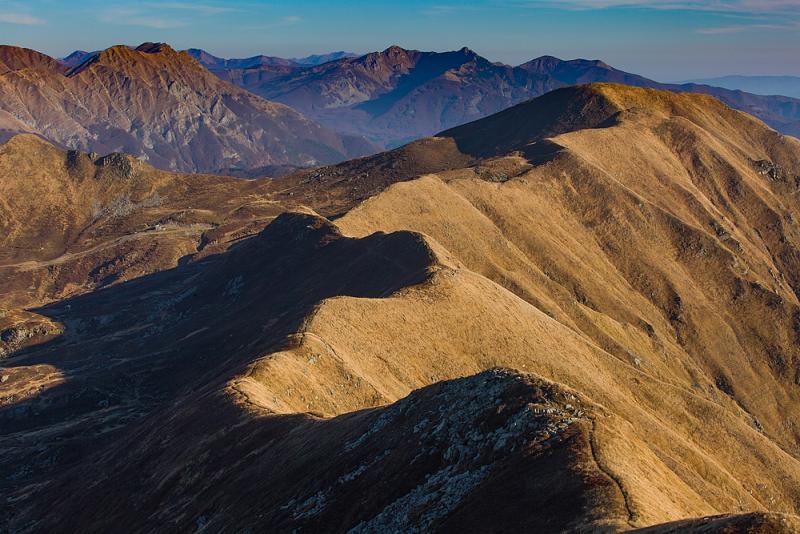The southern portion of the region of Emilia-Romagna (of which Bologna is the food-loving capital) is hilly and mountainous. Many of the region’s parks are concentrated in this area, and, especially along the ridge that divides Emilia-Romagna from Tuscany, with the Apennines being the natural border, are some of the most spectacular mountain landscapes. The parks are located in culture- and history-rich areas, inhabited since ancient times; many excellent food products can also be tasted.
Here are four of our favorite parks in Emilia-Romagna.
National Park of Tuscan-Emilian Apennines
This is one of two national parks in the region, and covers a portion of the ridge that divides Emilia-Romagna from Tuscany, from the Sillara Pass to the Forbici Pass. It is in the provinces of Parma and Reggio-Emilia and its lowest portion traverses a pretty countryside landscape at the heart of world-famous productions such as Parmigiano Reggiano and Prosciutto di Parma.
The Appennino Tosco-Emiliano National Park includes three of the highest peaks of the region, which are above 2000 meters: Monte Cusna, Prado and Alpe di Succiso. The top of these mountains are covered by blueberry pastures which, in the early fall, turn bright red making for a wonderful natural show. In the late spring and summer, their peaks get covered by the blooming of rare flowers which transform them into natural botanical gardens.
In the park is also the spellbinding Pietra di Bismantova, a limestone rock that emerges, isolated, in the Valley of the Secchia river. It is between 15 and 20 million years old, and was mentioned even by Dante in the Divine Comedy.

Regional Park of the High Modenese Apennines
This park borders the Appennino Tosco-Emiliano National Park and shares with it the same environment. Vast forests of beech trees cover the sides of the mountains; at the lowest altitudes, beech trees are substituted by chestnut and oak trees. Chestnut trees were once the most important element of the mountain economy as it provided food and wood for the local populations; as these areas were progressively abandoned after World War II, chestnut forests lost their importance, but there are still remnants of the local ‘chestnut culture’, as in the few mills that survive, sometimes emerging suddenly in the woods, or in local museums.

The Regional Park of the Alto Appennino Modenese includes the highest peak of the northern Apennines, the Mount Cimone (2165m). The hike to the top, where a weather station is positioned, is one the most popular in the park, often departing from the pretty Ninfa lake. It is said that the top of Mount Cimone is the place from where, on clear days, you can see most of Italy: in fact, you can see both the Adriatic and Thyrrenian Seas, the Alpine Arc, the Tuscan islands of Elba and Capraia, and even the French island of Corsica.
National Park of the Foreste Casentinesi, Monte Falterona and Campigna
This is an extremely important park as it guards one of the best preserved and most natural forests in all of Italy. The forests of the park, mostly beech trees, but also fir, have been lovingly cared for since the Middle Ages by the Benedictine monks who founded the Eremo di Camaldoli in the 11th century; today, the hermitage is still one of the major attractions of the park, overall suffused with spirituality. The Franciscan Sanctuary of La Verna, where Saint Francis retreated in meditation, is another attraction, as are the Acquacheta waterfalls, cited by Dante in his Divine Comedy.
The park includes Sasso Fratino, the first integral nature reserve in Italy, established in 1959, where only researchers are allowed to enter.

The National Park of the Foreste Casentinesi is located in the Tuscan-Romagnolo Apennines, and is shared between the regions of Emilia-Romagna and Tuscany. A significant population of deer lives in the park, and it is especially fascinating to visit in the fall, during mating season, when it is possible to hear the bellowing of the male deer trying to attract their female counterparts.
Regional Park of the Abbey of Monteveglio
This pleasant park in the hills near Bologna is located in the Valsamoggia, the valley traversed by the Samoggia creek. The area is illustrative of the typical hilly landscape that surrounds Bologna and makes for an easy day outing from the city.
The park centers around the ancient borgo of Monteveglio, which stands on top of a hill, and was in the Middle Ages part of the domains of the powerful Matilde di Canossa. The village includes the remains of the castle, which for centuries was disputed between the cities of Bologna and Modena; and the Romanesque Parish church of Santa Maria, one of the oldest pievi of the province of Bologna, which today houses a Franciscan community.

The park is especially beautiful to visit in the spring, when cherry trees are in full bloom and snowdrops announce the end of winter.
This is also an ideal place to observe an erosion phenomenon that is common in the region: the calanchi, areas where clay-rich soils have been extensively eroded by wind and water, forming steep slopes where vegetation can scarcely grow.
Bonus point: the park stands in the heart of Pignoletto wine production, the typical white wine of the Bolognese hills.




